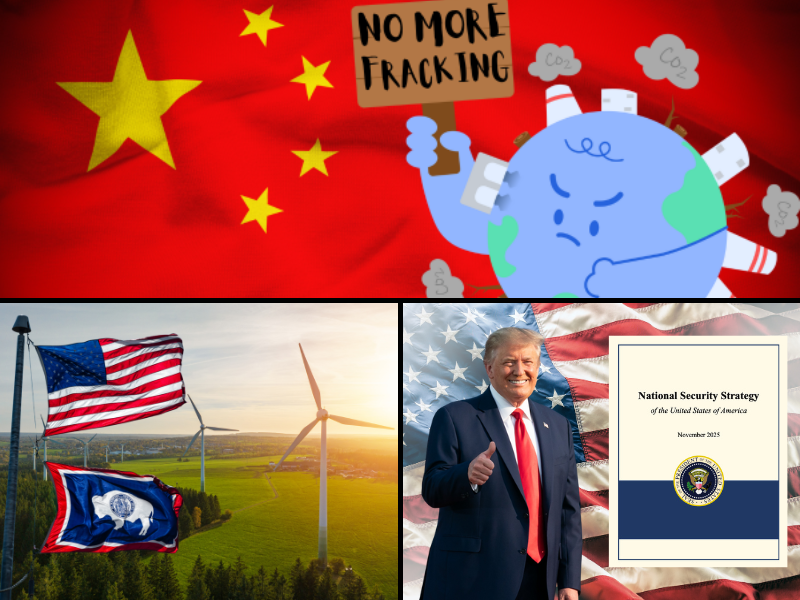The Heartland Institute’s 14th International Conference on Climate Change (ICCC-14) has come and gone, but its impact will continue. I encourage readers who were unable to attend to watch the videos of the conference online.
The theme of ICCC-14 was “The Great Reset: Climate Realism vs. Climate Socialism.” The program was a response to international elites’ push to exploit the supposed existential threat of climate change to get people to “reimagine capitalism,” in the words of Klaus Schwab, founder and executive chairman of the World Economic Forum. As described in numerous documents and discussions, the aim of those pushing the Great Reset (GR) is to impose socialism worldwide, especially on energy production and use, which is the foundation of the modern world.
The sessions included discussions of what climate science shows about humanity’s contribution to climate change; what danger, if any, it poses; how climate science has been corrupted; the economic impacts and the limits on liberty that flow from the Biden administration’s efforts to “fight climate change”; and more.
One of the subtlest and most perfidious paths through which the cabal of elitist activists, industrial and commercial interests, and national and international politicians and bureaucrats are trying to reset capitalism to prioritize “woke” social justice and green priorities is through the co-opting and takeover of global capital markets: banks, insurance, and stock and bond trading and investment.
My colleague Justin Haskins, director of The Heartland Institute’s Stopping Socialism project, has been writing and speaking about this topic for some time. Justin made a powerful, wide-ranging presentation on the topic during IPCC-14 (his presentation begins at about 1:00 on the video linked here.) Justin shows beyond any shadow of a doubt that in pursuit of a great reset, global elites from big banks to politicians to portfolio fund managers and international bureaucrats are working “jointly and swiftly, to revamp all aspects of our societies and economies, from education to social contracts to working conditions. … Every industry, from oil and gas to tech must be transformed. In short, we need a Great Reset of Capitalism,” as he characterizes Schwab’s stated goal.
Big financial institutions such as Bank of America and Mastercard, investment managers such as BlackRock and Vanguard, and hundreds of corporations are going all-in on the financial and commercial portion of the Great Reset, pushing environmental, social, and governance (ESG) metrics.
These powerful people and institutions would have ESG metrics replace capitalization, revenue, profits, and profit margins as the new way of evaluating businesses. Under ESG, returns on investment and returns to stockholders and owners are not as important in a company’s rankings as its embrace of left-wing causes. These causes include how “green” a company is, having the “right” ratio of minorities, avoiding involvement in politically disfavored industries (such gun manufacturing and fossil fuel production), and other such woke leftist considerations.
Companies are then given a score or rating to determine how well they align with ESG goals, and banks will use these scores to make lending and other commercial decisions, and portfolio managers will use them to determine investment recommendations and propose initiatives and board choices to be offered at annual meetings.
Hundreds of the world’s largest corporations, including financial institutions, have already implemented ESG systems and reporting metrics within their companies, and investor groups worth trillions of dollars have pledged to prioritize these companies over those that refuse to participate.
The climate change conference included a panel devoted to discussing this pernicious public/private sector partnership: “How to Oppose Woke Capital, Activist Investors, and Financial Regulators’ Efforts to Cancel Traditional Energy.” The panel featured Justin Danhof and Scott Shepard of the Free Enterprise Project—the only full-time conservative, pro-freedom, pro-market, investor activist organization—at the National Center for Public Policy Research and Stephen Soukup of the Political Forum Institute. The analysts discussed the growing trend of corporations putting aside fiduciary duties and concentrating on ESG goals, and the Biden administration’s efforts to require every business to make ESG goals its dominant concern. They detailed how this change in focus by big private-sector actors and the government has profound negative effects on shareholders, customers, and all of society. (The panel can be viewed here, beginning 5 hours, 11 minutes, and 45 seconds in).
Research consistently shows funds guided primarily by ESG goals receive lower returns and are far riskier than investment portfolios guided by profits and generation of wealth for their investor/owners.
The Trump administration tried to tap the brakes on efforts by corporations and federal agencies to impose social justice and environmental requirements. Trump policies included ensuring ERISA plans (pension plans operating under the Pension Reform Act of 1974) regulated by the Department of Labor be managed with a sole and unwavering focus on providing for the retirement security of American workers. Also under Trump, the U.S. Office of the Comptroller of the Currency proposed a rule aimed at ensuring fair access to banking services provided by national banks, federal savings associations, and agencies of foreign bank organizations.
The rule would have prohibited banks with more than $100 billion in assets from denying services such as lending and payment processing to businesses based on political considerations such as the type of industry they are in or whether they have adopted ESG codes, as opposed to normal business considerations, such as a company’s earnings, business prospects, assets, profit and loss statements, capitalization, and credit history.
Through a flurry of executive orders, Biden is actively rolling these rules back. Biden’s executive order on Climate-Related Financial Risks “mandates that Labor Secretary Marty Walsh submit a report to the director of the National Economic Council and the White House national climate advisor within 180 days that identifies actions taken by the agency ‘to protect life savings and pensions of U.S. workers and families from climate-related financial risk,’ and required the same of the Federal Retirement Thrift Investment Board, which administers the Thrift Savings Plan for federal employees,” 401K Specialist reports.
In addition, at Biden’s direction the U.S. Securities and Exchange Commission (SEC) has created a 22-member ESG Task Force to enforce the administration’s social justice and climate change goals. Simultaneously, the SEC issued a call for public comments on a rule to require publicly traded corporations, investment management firms, and mutual funds under its regulatory purview to disclose the climate-change-related risks and opportunities they might face.
In addition, the U.S. House of Representatives, under the control of radical Democrats, is trying to make hay while the Sun shines on these matters. House Democrats have already forced through a bill to mandate ESG disclosures for every business entity under the regulatory purview of the SEC, and they are considering a bill to make it harder for banks to lend to companies that develop, transport, or sell fossil fuels.
Some states, such as Texas, are fighting back against efforts to politicize investment. Texas enacted laws this year requiring public pension funds in the state to divest their holdings of companies that boycott or cut ties with fossil-fuel producers. Louisiana recently paused a $700 million oil and gas bond offering which would have been backed by JPMorgan Chase bank, because of the bank’s decision to ban banking operations with companies in the firearms industry.
It is no exaggeration to say the fate of people’s investments and pensions, whether people will be able to retire comfortably at a reasonable age, and whether markets will be used to build wealth or to push people in directions elites deem politically correct will be decided in the next two elections (federal, state, and local), in courtrooms, and during proxy battles at annual board meetings in the next few years.
To be forewarned and informed is to be forearmed. Act on this knowledge, and support organizations such as The Heartland Institute that are fighting against this Great Reset, or you will suffer the consequences.
SOURCES: ICCC-14; Climate Change Weekly; Environment & Climate News; Environment & Climate News
IN THIS ISSUE …
DEVELOPMENT GOALS UNDERMINING COP26 AMBITIONS … CHINA CASHING IN ON WEST’S GREEN-ENERGY OBSESSION
DEVELOPMENT GOALS UNDERMINING COP26 AMBITIONS
Developing countries contribute the largest share of anthropogenic greenhouse gas emissions, with China alone emitting more than all other developed countries combined. With this in mind, the U.N. Framework Convention on Climate Change’s (UNFCC) 26th Conference of the Parties (COP) cannot succeed. It is a horror show, appropriately scheduled to begin on Halloween, October 31, and run through November 12.
The first international climate treaty (1992) set a goal for developed nations to cap their greenhouse gas emissions at 1990 levels by 2000. They missed those targets, with emissions in developing and developed countries alike growing.
The second major international climate treaty came five years later. In 1997, COP participants signed the Kyoto Protocol, requiring developed countries to cut their greenhouse gas emissions by an average of 5 percent below 1990 levels (some countries were required to make sharper cuts; some could grow emissions) between 2008 and 2012. They missed those targets.
Eight years later in Paris, the COP set a new target of reducing emissions by the amount necessary to limit future temperature rise to less than 2 °C and try to limit the increase to 1.5 °C. This required developed countries to cut emissions by 50 to 80 percent or more by 2050, though the interim goals were on the order of 20 percent below 2015 levels by 2020 and 30 percent by 2030. For the first time, developing countries were to submit plans to cap emissions or at least substantially reduce their rate of growth. The Paris agreement also established a requirement that developed countries fully finance, with $100 billion per year beginning in 2020, a fund developing countries could access to adapt to climate change and adopt green technologies to enable development with minimal greenhouse gas emissions.
As the parties gather in 2020, once again the increasingly stringent and lofty goals of climate agreements have not been met. In fact, nearly 30 years have passed since the first agreement, and its minimal goals have yet to be reached. The green climate fund has not been fully capitalized, and the BBC reports COP26 President-Designate Alok Sharma is admitting the fund will probably not meet its 2020 target of $100 billion until 2023 at the earliest. Only one country, Gambia—a developing country with a vanishingly small greenhouse gas footprint—is on track to meet its emission reduction targets under the Paris agreement.
Per the Paris agreement, COP 26 is a time to set even more stringent goals, yet some of the most important players have decided not to play ball or at least not to play the same game as most of the COP. China, which under Paris said it expected its emissions to peak by 2030, and Saudi Arabia have both said they will not submit written greenhouse gas reduction commitments. In addition, India, the third-largest emitter of greenhouse gases, reports it will not agree to go net-zero. This is important because net-zero is what the IPCC now claims will be necessary to keep temperatures below the two-degree Celsius target—which is not surprising given that every time the nations miss a target the conference must set stricter limits to meet the ultimate goal during the next period.
Expect more of the same at COP 26: much handwringing, plenty of hyperbolic statements about disaster looming, backroom negotiations and arm twisting, and at the end of the conference, governments coming together to issue a statement saying they are committed to stopping climate change, making more empty promises of goals that won’t be met. In short, expect much sound and fury signifying a lot of costly, futile policies with little if any overall emission reductions to show for the enormous costs. That will lead us to the next COP round, where Kumbaya will be sung once again.
Greta will once again wag her finger, look outraged, and say “How dare you!” And the Nietzschean eternal recurrence—the bloviating speeches, futile negotiations, and grandstand politicking—will begin again.
SOURCES: iNews; The Times; The Express; Reuters; Times of India; BBC
CHINA CASHING IN ON WEST’S GREEN-ENERGY OBSESSION
A new report from the Global Warming Policy Foundation (GWPF) shows the green-energy policies pushed by politicians in the United Kingdom and demanded by the U.N. and the E.U. of the rest of the world are, contrary to promises, not leading to green jobs for the countries adopting them. Instead, net-zero policies are leaving Britons and others unemployed and with regularly failing electric power systems while enriching China, which is building and shipping the wind turbines and solar panels these nations are installing.
In the U.K., offshore oil and shipyard jobs are being lost, and promised wind and solar manufacturing jobs are either not being created or, where factories existed, they are being closed, as China provides the green technologies demanded for net-zero policies. Moreover, the technologies aren’t all that green, as detailed by Net Zero Watch. To manufacture wind and solar turbines, China is ramping up electric power production from coal-fueled power plants, increasing their emissions. In addition, huge ships burning fossil fuels are being used to transport these turbines and panels to their countries of demand.
Hypocritically, but strategically, China has announced it will stop funding new coal-fueled power plants in developing countries, to fight climate change. Net Zero Watch writes,
China’s cheap energy strategy will kill three birds with one stone:
1. By building up its coal-powered economy, it can continue to produce and export renewables much cheaper than most OECD nations. China will thus cement its role as the world’s foremost producer and exporter of renewable energy.
2. By ending support for building coal-fired power plants abroad it reduces the pressure on coal demand, improving China’s domestic coal market which is currently struggling with high coal prices.
3. By announcing this move, China is playing the green card in the run-up to COP26 in order to reduce Western pressure and kick the ball back into Joe Biden’s court.
Commenting on China’s strategic manipulation of politicians pushing net-zero policies and thus the demand for renewables, a market it dominates, Benny Peiser, GWPF’s director said,
The Net Zero climate policies are creating a divided and acrimonious international environment that will permit China to greatly enhance its global economic presence and political influence while the developed, democratic world becomes weaker in every way. Is that the world we want?
The astronomical costs of Net Zero are crippling Western economies at a crucial and alarming time in our relations with China. If we want to protect our freedom we need to put our economies and our national security first. That is the only way to deliver a stable and long-term climate policy, otherwise greenhouse gas emissions may be the least of our worries.
China dominates the markets for renewables for three reasons. Relative to the West it has lax environmental regulations, cheap labor markets, and low-cost energy reliant on coal. Climate Change Dispatch notes “energy prices in Scotland are usually well over double those in China and make up around a quarter of the cost of manufacturing items like turbine jackets. … Wages in China are also lower. In 2019, the average salary in Beijing and the industrial cities of the south was £16,500—just over half the UK rate.”
The U.K. government promised its green-energy push would create 28,000 direct jobs and more than 20,000 indirect jobs along Scotland’s coasts by 2020. As detailed in GWPF’s report, the result has been “1,190 full-time Scottish manufacturing jobs across all types of renewable energy, including hydropower, solar, onshore and offshore wind, and a further 1,000 ‘indirectly’ employed in the renewables supply chain.”
SOURCE: Climate Change Dispatch; Net Zero Watch; Global Warming Policy Foundation



